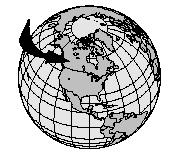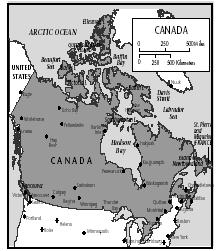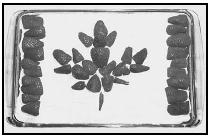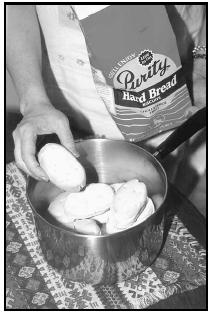Canada
Recipes

1 GEOGRAPHIC SETTING AND ENVIRONMENT
Canada is the world's second-largest country (after Russia), and is the largest country in North America. The eastern provinces, known as the Maritimes, are separated from the rest of the country by low mountain ranges. Newfoundland and Prince Edward Island are island provinces in the Atlantic Ocean.
Along the border with the United States in the center of Canada is a fertile plain bounded by the Saint Lawrence River, Lake Ontario, and the Hudson Bay. Also along the U.S. border further to the west are farms and ranches. Extending through western Alberta to the Pacific Ocean is the northern portion of the Rocky Mountain range. Mount Logan, at 19,524 feet (5,915 meters) the highest peak in Canada, is near the Alaska border. The climate varies across the vast Canadian territory. The west coast gets about 60–120 inches (150–300 centimeters) of rain each year; the center part of the country gets less that 20 inches (50 centimeters), and the Maritime provinces 45–60 inches (115–150 centimeters). In British Columbia, there are 252 rainy days each year, but in the center of the country, there are just 100.
2 HISTORY AND FOOD
France and England battled over who would colonize the territory of Canada in the late 1400s. The English explorer John Cabot arrived in Newfoundland in 1497. About 40 years later in 1534, Jacques Cartier began his exploration of Canada on behalf of France. By the early 1600s, there were permanent French colonies, and in 1663, New France was established as a territory of France. French fur traders competed with the traders of the Hudson's Bay Company, run by British merchants. Wars in North America, known as the French and Indian wars, were waged in the 1700s. The Treaty of Paris in 1763 ended the armed fighting and established British rule over all of the territory formerly called New France.

In 1846 conflict over the western portion of the United States–Canada border was resolved, and the border was set at 49°north latitude. This border has been undisputed every since.
Food and other customs in Canada still carry hints of the colonial influences of England and France. Canadians speak English except in Quebec, where the language is French, reflecting the influence of French settlers. But there are other regional differences in food and customs, too.
Food in the provinces of Eastern Canada shows signs of English heritage, except in Quebec where the influence is French. In the provinces of Western Canada, the cuisine reflects the explorers and settlers, who, like their southern neighbors in the United States, made simple, hearty meals from available ingredients. In northern Canada—Northwest, Yukon, and Nunavut territories—the diet is limited by the short growing season, dominated by preserved food ingredients, and influenced by the native Inuit diet. And along the west coast in British Columbia, immigrants from Asian nations influence food and cultural practices. In Vancouver in the west and Toronto in the east (and in many places elsewhere in Canada), Lunar New Year celebrations were inspired by the citizens of Asian heritage living there, but are enjoyed by many other Canadians as well.
3 FOODS OF THE CANADIANS
The favorite foods of Canadians vary slightly from region to region, and are strongly influenced by their family heritage, especially in relation to holiday celebrations. Along the Atlantic coast, seafood and dishes derived from English traditions (except in Quebec) are common. In Quebec, favorite foods come from the area's French heritage. Throughout Canada, maple syrup and maple products are popular, reflecting the significance of the maple tree, whose leaf adorns the flag of Canada. Many families enjoy a visit in early spring to a maple sugar "shack," the special rustic building where sap from maple trees is boiled in a large open pan to make maple syrup.
Later in the spring, many people in Eastern Canada visit a wooded area to harvest fiddleheads. Fiddleheads, named because they look like the coiled end of a violin ("fiddle"), are the tasty new sprouts of woodland ferns, picked before they develop into large lacy fronds. They are a fragile spring specialty, usually available for just a few weeks in the spring. Grocery stores in Canada may stock frozen fiddleheads alongside other frozen vegetables.
Sauteed Fiddleheads
Ingredients
- 1 bunch fiddleheads
- 1 Tablespoon butter
- 1 Tablespoon olive oil
Procedure
- Trim the fiddleheads so that the stem end is about 2 inches long. Rub the dry brown flakes off the fiddleheads, and rinse well.
- Fill a saucepan with cool water and plunge the fiddleheads into the water to rinse off any grit.
- Remove the fiddleheads from the pan, change the water, and repeat the soaking. Rinse the fiddleheads under running water to remove any remaining grit.
- Rinse and dry the saucepan. Measure oil and butter into it and heat until the butter is melted.
- Add the fiddleheads and sauté, stirring with a wooden spoon, for about 5 minutes. Fiddleheads will be bright green and crispy.
Serves 8 to 10.
Canadian Bacon with Maple Glaze
Ingredients
- ½ cup cider vinegar
- ¾ cups maple syrup
- 1 Tablespoon brown sugar
- 1 pound (approximately) Canadian bacon
Procedure
- Preheat oven to 300°F (150°C).
- Combine vinegar, maple syrup, and brown sugar in a bowl. Set aside.
- Slice Canadian bacon about ½-inch thick. Arrange the slices in a casserole or baking dish, and spoon the syrup mixture over the slices.
- Bake for 30 minutes. Serve hot or at room temperature. (To serve as a snack, cut slices into bite-sized pieces and serve with toothpicks.)
Serves 6 for lunch or dinner, or 15 to 20 as a snack.
Western Canadians enjoy the products of the large ranches and farms in that part of the country. Barbecued food, beef, and corn dishes, such as Sweet Corn Pancakes, are popular. Berries such as blueberries and saskatoon berries, are popular accompaniments to pancakes, waffles, and are often made into syrups, jams and preserves.
Sweet Corn Pancakes
Ingredients
- 6 eggs, separated (Note: to separate eggs, crack the egg and allow just the white to fall into a bowl, holding the yolk in one of the shell halves. Transfer the yolk back and forth between the two shell halves, being careful not to break it, until all the white has dripped into the bowl. Put the yolk into a separate bowl.)
- ¼ cup half-and-half
- 1 Tablespoon sour cream
- ⅓ cup flour
- 1 teaspoon baking soda
- 1 teaspoon baking powder
- ½ cup corn (may be fresh or frozen corn kernels)
- Vegetable oil to oil the pan
Procedure
- Beat the egg whites until they hold soft peaks when the beaters are lifted up.
- In another bowl, combine the egg yolks, half-and-half, and sour cream.
- Gradually add the dry ingredients to the egg yolk mixture. Add the beaten egg whites, using a gentle stirring motion to combine them with the yolk mixture.
- Add the corn, and stir gently. Pour a small amount of oil into a non-stick pan and heat it over medium heat. Drop batter, about 1 Tablespoonsful at a time, into the pan for each pancake and cook until golden brown on each side.
Serves 4 to 6.
While Canada is known to some for its beers (such as Molson and Labatts), nonalcoholic beverages that are favorites in Canada are spruce beer (made from spruce trees, a specialty of eastern Canada), and apple and cherry ciders.
4 FOOD FOR RELIGIOUS AND HOLIDAY CELEBRATIONS
Canadian Thanksgiving is celebrated on the second Monday in October. A typical menu for Thanksgiving is similar to that served in the country's neighbor to the south, the United States.
Thanksgiving
Beet Soup
Roast Turkey with Corn Bread Stuffing
Cranapple Relish
Brussels Sprouts
Mashed Potatoes
Burnished Squash Wedges
Pumpkin Pie
Burns Day is celebrated January 25 to commemorate the birthday of poet Robert Burns (1759–96). It is especially significant for people of Scottish descent worldwide, and Scots Canadians are no exception. On Burns Day, the menu includes such Scottish favorites as haggis, cockaleekie soup (chicken-based leek soup), and Dundee cake (a rich fruitcake).
Canada Day Cake
Ingredients
- 1 white or yellow cake mix
- 1 container white frosting
- 1 quart strawberries
- Picture of flag of Canada
Procedure
- Prepare cake according to package directions. Bake in a 9-inch by 13-inch cake pan. Allow cake to cool.
- Frost cake with white frosting. Using a knife or spatula, make surface of frosting as smooth as possible. (It may help to dip the knife or spatula into a glass of water.
- Slice the strawberries, and arrange in rows at the left and right edges of the cake to represent the stripes at the edges of Canada's Maple Leaf Flag.
- Referring to the picture of the flag, arrange the slices strawberries in the center of the cake to represent the Maple Leaf.
Serves 24.
On Canada Day (July 1), Canadians celebrate with picnics and fireworks (similar to the Fourth of July in the United States). Dishes served are typical casual dining fare, such as hamburgers, hot dogs, and table settings feature the patriotic color scheme of Canada's red and white maple leaf flag.
A common treat served across Canada is the nanaimo bar. It is believed that nanaimo bars, a sweet bar cookie made in layers, originated in the 1950s in the Vancouver area, when a recipe was published in the

Nanaimo Bars
Nanaimo Bars have three layers.
Ingredients for bottom layer
- ½ cup butter
- ¼ cup sugar
- ⅓ cup unsweetened cocoa
- 1 egg
- 1 teaspoon vanilla
- 2 cups crushed graham crackers (packaged graham cracker crumbs may be used)
- 1 cup shredded coconut
- ½ cup chopped walnuts
Ingredients for middle layer
- ¼ cup butter
- 2 cups confectioners' sugar
- 2 Tablespoons vanilla custard powder (available in Canada, but not in the United States; instant vanilla pudding powder may be substituted)
- 3 Tablespoons milk
Ingredients for top layer
- 4 ounces semi-sweet chocolate
- 1 Tablespoon butter
Procedure
- Make bottom layer: Grease a 9-inch square cake pan.
- Combine ½ cup butter, sugar, cocoa, egg, and vanilla in a heavy sauce pan. Heat over low heat, stirring constantly, until mixture thickens.
- Add graham crackers crumbs, coconut, and chopped walnuts, stirring to combine. Press the mixture in the greased pan.
- Make middle layer: Beat together ¼ cup butter, confectioners' sugar, vanilla custard or pudding powder, and milk, until the mixture is creamy.
- Spread over graham cracker base in cake pan. Refrigerate bars until firm, at least 1 hour.
- Make topping: Melt semi-sweet chocolate and 1 Tablespoon butter. Drizzle over chilled bars. Return to refrigerator to chill until firm (at least 1 hour).
- Cut into squares and serve.
Serves 16.
5 MEALTIME CUSTOMS
Most Canadians eat three meals each day, with breakfast featuring cold cereal, pastries, fruit juices, and hot beverages such as

For dinner, depending on where they live, Canadians may have seafood (west coast or Maritime east coast provinces), beef (western Canada, especially Alberta), or chicken or pork. Many Canadians enjoy gravy, serving it frequently with potatoes prepared in many different ways. A traditional Newfoundland dish, Fish and Brewis, features ingredients that may be stored through the long winter months. Desserts featuring maple syrup, such as Maple Syrup Upside-Down Cake or a simple Maple Sundae, are popular treats.
Maple Sundae
Ingredients
- 3 Tablespoons pure maple syrup
- Vanilla ice cream
- Chopped nuts (optional)
- Whipped topping (optional)
Procedure
- Spoon vanilla ice cream into bowls.
- Drizzle about 3 Tablespoons of maple syrup over the ice cream.
- Top with chopped nuts and whipped topping (if desired), and serve immediately.
Serves 1.
Fish and Brewis
- 2 pounds salt cod
- 6 loaves Hard Bread (not readily available in the United States; see Source of Special Ingredients)
- 1 cup salt pork
Procedure
- Place salt cod in a saucepan, cover with water, and allow to soak overnight. Place Hard Bread in another saucepan, cover with water, and allow this to soak overnight also.
- Make fish: Drain salt cod and return to saucepan. Refill saucepan with fresh water, heat to simmering, and cook, covered, for 20 minutes. Drain, flake the fish into serving-sized pieces, and arrange with Hard Bread (called brewis ) on a serving platter.
- Make brewis (Hard Bread): Do not drain Hard Bread. Heat over medium-low heat until water simmers. Simmer, covered, for about 15 minutes. Drain and place cooked Hard Bread, known as brewis , on a serving platter with fish. Place the platter, loosely covered, in the oven on the lowest setting to keep warm.
- Make scrunchions: Dice the salt pork into small cubes and sauté them in a skillet until golden brown.
- Serve the fish and brewis, topped with scrunchions.
Serves 6 to 8.
Maple Syrup Upside-Down Cake
Ingredients
- 1 cup maple syrup
- 1 Tablespoon butter, softened
- 3 Tablespoons sugar
- 1 egg
- 1 cup flour
- 2 teaspoons baking powder
- Pinch of salt
- ¼ teaspoon cinnamon or nutmeg
- ½ cup milk
- ¼ cup chopped walnuts (optional)
- Vanilla ice cream or whipped topping as accompaniment (optional)
Procedure
- Preheat oven to 350°F (175°C)
- Measure butter, sugar, and egg into a bowl, and beat with a wooden spoon or electric mixer until creamy.
- Mix flour, baking powder, salt, and cinnamon (or nutmeg) together. Add the dry ingredients and the milk, a little at a time and alternating between the two, to the creamed butter mixture. Stir until well blended.
- Measure syrup into a small saucepan. Heat the syrup until it boils, and pour into a generously buttered 8-inch square baking pan. If using chopped walnuts, add them to the hot syrup.
- Scoop up the dough in four large balls and drop them into the hot maple syrup. Using two forks, stretch dough the edges of the balls until the dough forms one large mass. Bake at 350°F (175°C) for 30 minutes.
- Serve warm, with ice cream or whipping cream (if desired).
Serves 16.
6 POLITICS, ECONOMICS, AND NUTRITION
Only about 5 percent of Canada's land is considered arable (able to grow crops), and agriculture contributes about 2 percent to the country's gross domestic product. The trend is toward larger farms. Canadian farms produce grains such as wheat, barley, corn, and oats. Canada ranks third in the world in grain exports. Canadian farmers and ranchers also raise livestock for export, especially in Alberta, Saskatchewan, and Manitoba.
7 FURTHER STUDY
Books
Barbolet, Herb. Farm Folk, City Folk: Stories, Tips, and Recipes Celebrating Local Food for Food Lovers of All Stripes. Vancouver: Douglas & McIntyre, 1998.
Barer-Stein, Thelma. You Eat What You Are: People, Culture, and Food Traditions. 2nd ed. Toronto, Ont.: Firefly Books, 1999.
Chavich, Cinda. The Wild West Cookbook. Don Mills, Ont.: R. Rose, 1998.
Claman, Marcy. Rise & Dine Canada: Savory Secrets from Canada's Bed & Breakfast Inns. 2nd ed. Montreal, Quebec: Callawind Publications, 1999.
London, Jonathan. The Sugaring-Off Party. New York: Dutton, 1994. [Picture-book account of maple sugaring in Canada.]
Stewart, Anita. Great Canadian Cuisine: The Contemporary Flavours of Canadian Pacific Hotels. Vancouver, BC: Douglas & McIntyre, 1999.
Web Sites
Canada Day Cake Recipe. [Online] Available http://www.mochasofa.com/apps/recipes/RecipeDetail.asp?RecipeId=975 (accessed June 1, 2001).
Liboiron, Henri and Bob St-Cyr. "Making Pemmican." [Online] Available http://collections.ic.gc.ca/notukeu/pemmican_e.htm (accessed April 17, 2001).
Root, Lorna. "Food and More: Canadian Cuisine." [Online] Available http://www.geocities.com/lorna_lynne/recipes/recipe1.html (accessed April 17, 2001).
Source for Special Ingredients
Always Canadian. [Online] Available http://www.alwayscanadian.com (accessed August 17, 2001).
We eat a lot of grains: breads, cereals, ...
We eat hearty vegetables that are easy to store in our harsh winters: potatoes, parsnips, carrots, green or yellow beans, peas, corn, ...
We have many berries that grow so we love jams, jellies, pies and pastries made with blueberries, raspberries, Saskatoon berries, blackberries, ...
We eat a lot of meats that we raise on our land: beef, chicken or turkey, pork. We also have some lamb, various game birds like pheasant, Cornish hens, quail. We also hunt wild animal and a popular thing to do is to make sausage out of the meat - ie: deer, elk, moose... And buffalo is becoming more popular - an animal that is tied to our rich history.
Because of our vast farm land, we grow alternative crops of beans and lentils. Much of this is exported but is becoming more and more popular within our own cultural foods as well.
In our coastal areas (both east and west) we eat a LOT of seafood ranging from west coast salmon to east coast lobster and cod fish.
There are very unique ways of preserving many foods that we eat - from canning to drying or smoking. Have you ever had a smoked maple salmon candy?
We have our own versions of many other cultures ethnic foods. I am from the prairies so I think of a lot of eastern European foods like perogies, borscht, and Kolbassa. But Canadian "Chinese Food" is quite different than Chinese food. An Italian would tell you that having pizza in Canada is not anything like having it in Italy! And of course French fries are not very Canadian but poutine is uniquely ours!
Bon Appetit!